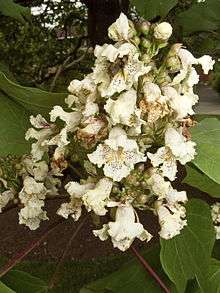Catalpa ovata
Catalpa ovata, the yellow catalpa[1][5] or Chinese catalpa[1] (Chinese: 梓; pinyin: zǐ), is a pod-bearing tree native to China. Compared to C. speciosa, it is much smaller, typically reaching heights between 20 and 30 feet (6 and 9 m). The inflorescences form 4–10-inch-long (100–250 mm) bunches of creamy white flowers with distinctly yellow tinging; individual flowers are about 1 inch (25 mm) wide. They bloom in July and August.[5] The leaves are very similar in shape to those of Paulownia tomentosa, having three lobes (two are abruptly truncated on either edge, with a third, central, slightly acute, pointed lobe forming the leaf apex), and are darkly green.[5][6] Fruits are very narrow, foot-long pods.[5]
| Catalpa ovata | |
|---|---|
 | |
| Flowers | |
| Scientific classification | |
| Kingdom: | Plantae |
| Clade: | Tracheophytes |
| Clade: | Angiosperms |
| Clade: | Eudicots |
| Clade: | Asterids |
| Order: | Lamiales |
| Family: | Bignoniaceae |
| Genus: | Catalpa |
| Species: | C. ovata |
| Binomial name | |
| Catalpa ovata | |
| Synonyms[2][3][4] | |
Although native to the more temperate provinces within China (Anhui, Gansu, Hebei, Heilongjiang, Henan, Hubei, Jiangsu, Jilin, Liaoning, Nei Monggol, Ningxia, Qinghai, Shaanxi, Shandong, Shanxi, Sichuan, Xinjiang),[1] C. ovata is also cultivated in North America and Europe, and has become a parent of Catalpa × erubescens with the American species Catalpa bignonioides.[1][5] It is commonly used to make the undersides of qin.[7]
 Tree in flower in cultivation at the Birmingham Botanical Gardens
Tree in flower in cultivation at the Birmingham Botanical Gardens Leaves and pods
Leaves and pods Closeup of mature Catalpa ovata at sunset
Closeup of mature Catalpa ovata at sunset
Chemistry
The plant contains dehydro-alpha-lapachone[8] (DAL) which inhibits vessel regeneration, interferes with vessel anastomosis, and limits plexus formation in zebrafish.[9] DAL also controlled the development of the fungi rice blast, tomato late blight, wheat leaf rust, barley powdery mildew and red pepper anthracnose (Colletotrichum coccodes (Wallr) S Hughes). The chemical was particularly effective in suppressing anthracnose.[10]
References
- Gen. hist. 4:230. 1837 "Catalpa ovata". Germplasm Resources Information Network (GRIN). Agricultural Research Service (ARS), United States Department of Agriculture (USDA). Retrieved December 7, 2009.
- Gen. Hist. iv. 230. Plant Name Details for Catalpa ovata. IPNI. Retrieved December 7, 2009.
Notes: =Kaempferi
- Abh. Akad. Muench. iv. III. (1846) 142. Plant Name Details for Catalpa kaempferi. 4. IPNI. Retrieved December 7, 2009.
Notes: Japon
- "Catalpa ovata - G.Don". Plants For A Future. Archived from the original on July 6, 2010. Retrieved December 7, 2009.
- Phillips, Roger (1978). Trees in Britain, Europe and North America. Cavaye Place, London, England: Pan Books Ltd. p. 96. ISBN 978-0-330-25480-9.
- Phillips, Roger (1978). Trees in Britain, Europe and North America. Cavaye Place, London, England: Pan Books Ltd. p. 42. ISBN 978-0-330-25480-9.
- Yeung, Juni (2010). Standards for the Guqin February 2010 Draft. Toronto: Toronto Guqin Society.
- Dehydro-alpha-lapachone Archived 2012-04-02 at the Wayback Machine
- Garkavtsev I, Chauhan VP, Wong HK, Mukhopadhyay A, Glicksman MA, Peterson RT, Jain RK.,"Dehydro-alpha-lapachone, a plant product with antivascular activity." Proc Natl Acad Sci USA. 2011 Jul 12;108(28):11596-601
- Cho, JY; Kim, HY; Choi, GJ; Jang, KS; Lim, HK; Lim, CH; Cho, KY; Kim, JC (2006). "Dehydro-alpha-lapachone isolated from Catalpa ovata stems: Activity against plant pathogenic fungi". Pest Management Science. 62 (5): 414–8. doi:10.1002/ps.1180. PMID 16550502.
- "Chinese Text Project Dictionary".
External links
![]()
![]()